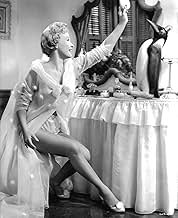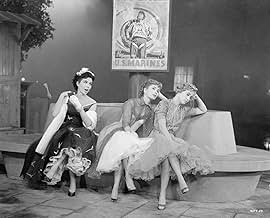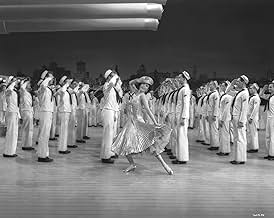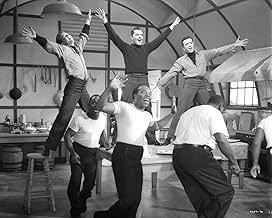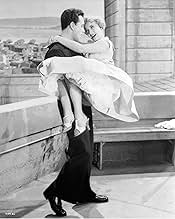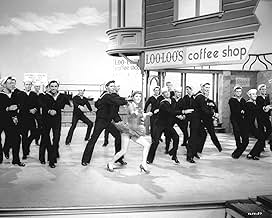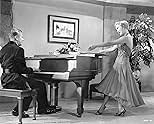AVALIAÇÃO DA IMDb
6,5/10
1,1 mil
SUA AVALIAÇÃO
Adicionar um enredo no seu idiomaThree sailors come ashore in San Francisco and take the city by storm, but can they win the hearts of three women by song?Three sailors come ashore in San Francisco and take the city by storm, but can they win the hearts of three women by song?Three sailors come ashore in San Francisco and take the city by storm, but can they win the hearts of three women by song?
- Direção
- Roteiristas
- Artistas
- Prêmios
- 1 vitória no total
The Jubalaires
- Themselves
- (as Jubalaires)
Jerry Antes
- Dancer
- (não creditado)
Jimmy Brooks
- Dancer
- (não creditado)
Buddy Bryan
- Dancer
- (não creditado)
Avaliações em destaque
This may have been made in the dying days of MGM musicals. No Sinatra. No Kelly. But it has some spectacular classic songs by Vincent Youmans. Plus 2 of the finest voices of all time singing together:
Tony Martin & Vic Damone. AND superior musical arrangements & Russ Tamblyn dancing.
Never mind the negative reviews elsewhere. They do not make them like this any more. For sure. So enjoy it! Great musical!!
Tony Martin & Vic Damone. AND superior musical arrangements & Russ Tamblyn dancing.
Never mind the negative reviews elsewhere. They do not make them like this any more. For sure. So enjoy it! Great musical!!
Three sailors can't stay out of trouble. Be it with the girls, mom, or conniving dandies. Plenty of action is provided through song and dance routines where everyone gives fine performances. While this was not a great musical, it was still a nice little story with some good funny spots supplied by J. Carroll Naish and Alan King.
Some films aren't simply movies-they're time capsules. Hit the Deck (1955), Roy Rowland's lavish adaptation of the 1927 stage musical, shines as a heartfelt homage to the mid-century American musical. It dances through moments of joy, romance, and camaraderie with a sense of purpose: to entertain. While it may lack the narrative finesse of MGM's greatest musicals, its exuberance, star-studded cast, and showstopping numbers make it a delightful-if imperfect-experience.
Hit the Deck carries a legacy that spans decades. Originally a stage musical in 1927 and based on Hubert Osborne's play Shore Leave (1922), it was a roaring success in its day. The story-about love and mischief during sailors' shore leave-captured the carefree spirit of the Roaring Twenties. The stage version's music, penned by Vincent Youmans, became an instant hit, with songs like "Sometimes I'm Happy" and "Hallelujah!" embedding themselves in popular culture.
The transition to screen began with RKO's 1930 adaptation, but MGM's 1955 version added new gloss. By then, the studio was desperate to revive a flagging genre, competing with the rise of television. Roy Rowland's film introduced CinemaScope technology and dazzling Technicolor to reinvigorate the classic material. The film wasn't just a rehash; it aimed to give a modern spin to its predecessors, resulting in a product both nostalgic and forward-looking.
The film's casting is an ode to MGM's star system, featuring legends Jane Powell, Debbie Reynolds, Ann Miller, and Tony Martin. While Powell and Reynolds brought youthful charm and vocal prowess, Miller's fiery energy and tap-dancing skills stole every scene she was in. Russ Tamblyn, despite not being a trained dancer, demonstrated an effortless athleticism that added an endearing spontaneity to his role as the impish Danny.
Behind the camera, choreographer Hermes Pan-Fred Astaire's long-time collaborator-imbued the musical numbers with a sense of joy and improvisation. The battleship finale reprise of "Hallelujah!" is a crowning achievement, blending spectacle with intimacy as sailors and civilians unite in a rousing, free-spirited celebration. The funhouse sequence with Reynolds and Tamblyn is another standout, echoing Fred Astaire's playful "Stiff Upper Lip" number from A Damsel in Distress.
The plot, while serviceable, was less memorable than the musical numbers. It follows three sailors on shore leave, their romantic entanglements, and the inevitable hijinks that ensue. The narrative feels like a patchwork quilt-disjointed but colorful-allowing the cast's charm and musical set pieces to take precedence over storytelling.
At its release, Hit the Deck struggled to recoup its substantial production costs. With box office losses of $454,000, it marked a decline in the MGM musical's golden era. Critics were lukewarm, praising the performances but pointing out the contrived plot and uneven pacing. Audiences, however, found joy in its dazzling musical numbers and the chemistry of its ensemble cast.
Over time, the film has garnered a loyal following among musical enthusiasts. Its inclusion in That's Entertainment! (1974) brought renewed attention, particularly to the finale sequence of "Hallelujah!" This number, celebrated for its improvisational charm, has been hailed as one of MGM's most freewheeling and joyous creations. Russ Tamblyn's athletic performance and Ann Miller's sizzling solo continue to be highlights for fans of classic Hollywood choreography.
The film also represents a bittersweet farewell for many of its stars. Jane Powell, Tony Martin, and J. Carrol Naish made their final MGM appearances here, while Debbie Reynolds and Russ Tamblyn stayed on for a few more years. Their performances encapsulate an era of cinematic magic that, while fading, left a lasting impression.
Hit the Deck may not be MGM's most polished gem, but it shines with the unrestrained joy and heartfelt performances that defined a bygone era. It reminds us of the sheer pleasure of escapist cinema-a kind that only classic Hollywood could deliver. If you're in the mood for vibrant colors, timeless melodies, and a touch of nostalgia, this musical is well worth revisiting.
Hit the Deck carries a legacy that spans decades. Originally a stage musical in 1927 and based on Hubert Osborne's play Shore Leave (1922), it was a roaring success in its day. The story-about love and mischief during sailors' shore leave-captured the carefree spirit of the Roaring Twenties. The stage version's music, penned by Vincent Youmans, became an instant hit, with songs like "Sometimes I'm Happy" and "Hallelujah!" embedding themselves in popular culture.
The transition to screen began with RKO's 1930 adaptation, but MGM's 1955 version added new gloss. By then, the studio was desperate to revive a flagging genre, competing with the rise of television. Roy Rowland's film introduced CinemaScope technology and dazzling Technicolor to reinvigorate the classic material. The film wasn't just a rehash; it aimed to give a modern spin to its predecessors, resulting in a product both nostalgic and forward-looking.
The film's casting is an ode to MGM's star system, featuring legends Jane Powell, Debbie Reynolds, Ann Miller, and Tony Martin. While Powell and Reynolds brought youthful charm and vocal prowess, Miller's fiery energy and tap-dancing skills stole every scene she was in. Russ Tamblyn, despite not being a trained dancer, demonstrated an effortless athleticism that added an endearing spontaneity to his role as the impish Danny.
Behind the camera, choreographer Hermes Pan-Fred Astaire's long-time collaborator-imbued the musical numbers with a sense of joy and improvisation. The battleship finale reprise of "Hallelujah!" is a crowning achievement, blending spectacle with intimacy as sailors and civilians unite in a rousing, free-spirited celebration. The funhouse sequence with Reynolds and Tamblyn is another standout, echoing Fred Astaire's playful "Stiff Upper Lip" number from A Damsel in Distress.
The plot, while serviceable, was less memorable than the musical numbers. It follows three sailors on shore leave, their romantic entanglements, and the inevitable hijinks that ensue. The narrative feels like a patchwork quilt-disjointed but colorful-allowing the cast's charm and musical set pieces to take precedence over storytelling.
At its release, Hit the Deck struggled to recoup its substantial production costs. With box office losses of $454,000, it marked a decline in the MGM musical's golden era. Critics were lukewarm, praising the performances but pointing out the contrived plot and uneven pacing. Audiences, however, found joy in its dazzling musical numbers and the chemistry of its ensemble cast.
Over time, the film has garnered a loyal following among musical enthusiasts. Its inclusion in That's Entertainment! (1974) brought renewed attention, particularly to the finale sequence of "Hallelujah!" This number, celebrated for its improvisational charm, has been hailed as one of MGM's most freewheeling and joyous creations. Russ Tamblyn's athletic performance and Ann Miller's sizzling solo continue to be highlights for fans of classic Hollywood choreography.
The film also represents a bittersweet farewell for many of its stars. Jane Powell, Tony Martin, and J. Carrol Naish made their final MGM appearances here, while Debbie Reynolds and Russ Tamblyn stayed on for a few more years. Their performances encapsulate an era of cinematic magic that, while fading, left a lasting impression.
Hit the Deck may not be MGM's most polished gem, but it shines with the unrestrained joy and heartfelt performances that defined a bygone era. It reminds us of the sheer pleasure of escapist cinema-a kind that only classic Hollywood could deliver. If you're in the mood for vibrant colors, timeless melodies, and a touch of nostalgia, this musical is well worth revisiting.
HIT THE DECK is a 1955 cinema scope mop up of MGM stars and talent whose contracts would have been soon to expire. A bit like a aircraft carrier version of DEEP IN MY HEART it hangs together a roster of singing and dancing talent but this time with ultimately fairly just-OK songs and energetic dance numbers. Still, even at its most bland it is still unable to be made in Hollywood today. The women are the most interesting talent on offer and whoever said Tony Martin had an audience apart from Mummas in delicatessens was truly misled. He is the most annoying part of this B grade musical with A grade MGM production values. Like he did with the Marx Bros films in the 30s. Kelly was making ITS ALWAYS FAIR WEATHER another 'sailors on leave' 1955 cinema scope MGM musical at the same time and that film with its Comden Green script and songs is light years ahead in sophistication and quality. Still HIT THE DECK has a two of very entertaining 'big' dance numbers, in particular the "finale" and the "Bayou" sizzler with its very erotic and blatant imagery and choreography. It is so out of place in this 'suburban' film as it is sooo good. The color is also very good for Eastman since MGM saw the error of their ways and stopped using horrible Ansco color which visually marred several big films in 53 and 54. This must have been as safe a bet in which MGM could expect to play out as many stars as possible in yet one more sailor musical. Russ Tamblyn and Debbie Reynolds are always cute in this era though.
... from six years earlier: three sailors on leave in the big city, except in Hit the Deck, the metropolis is San Francisco. The sailors are played by Russ Tamblyn, Tony Martin, and Vic Damone. They cross paths with Jane Powell, Debbie Reynolds, and Ann Miller. There are some fun musical numbers, notably Keeping Myself for You, and Lady From the Bayou, fabulously performed by Ann Miller dancing up a storm against rich color backgrounds and sets. Another uplifting tune was Hallelujah!
I found the film's energy peaked whenever Ann was on screen. (Ann also appeared in On the Town.) Jane Powell's part was terribly underwritten. Jane had more chemistry with Gene Raymond, the older married man she was seeing, then with Vic Damone, who ends up winning her heart. Walter Pidgeon is also on hand, playing an Admiral and father to Jane and Russ. Hit the Deck is a second tier MGM musical, which, considering the many masterpieces the studio turned out, is still very good.
I found the film's energy peaked whenever Ann was on screen. (Ann also appeared in On the Town.) Jane Powell's part was terribly underwritten. Jane had more chemistry with Gene Raymond, the older married man she was seeing, then with Vic Damone, who ends up winning her heart. Walter Pidgeon is also on hand, playing an Admiral and father to Jane and Russ. Hit the Deck is a second tier MGM musical, which, considering the many masterpieces the studio turned out, is still very good.
Você sabia?
- CuriosidadesBased on his athletic dancing in films such as this one and O Pequeno Polegar (1958), most audiences assume that Russ Tamblyn was a trained dancer. In fact, the actor had no history of dance training. He was a skilled tumbler, and that was originally slated to be his singular contribution to Sete Noivas para Sete Irmãos (1954), but his natural movement ability was so accomplished that he was incorporated more and more into the dance sequences. This would ultimately culminate in his being cast as Riff in Amor, Sublime Amor (1961), one of the most dance-heavy musicals in Broadway history.
- Citações
Chief Boatswain's Mate William F. Clark: Ginger, baby, I worship the ground you walk on!
Ginger: Now he's talking real estate!
- Cenas durante ou pós-créditosAnd Introducing Kay Armen
- ConexõesFeatured in 1955 Motion Picture Theatre Celebration (1955)
- Trilhas sonorasOverture (Join the Navy)
(1927) (uncredited)
Music by Vincent Youmans
Lyrics by Leo Robin and Clifford Grey
Performed by the MGM Studio Orchestra and Chorus Conducted by George Stoll
Principais escolhas
Faça login para avaliar e ver a lista de recomendações personalizadas
- How long is Hit the Deck?Fornecido pela Alexa
Detalhes
Bilheteria
- Orçamento
- US$ 2.300.000 (estimativa)
- Tempo de duração1 hora 52 minutos
- Mixagem de som
- 4-Track Stereo(original master sound track)
- Proporção
- 2.55 : 1
Contribua para esta página
Sugerir uma alteração ou adicionar conteúdo ausente

Principal brecha
By what name was Marujos e Sereias (1955) officially released in India in English?
Responda

